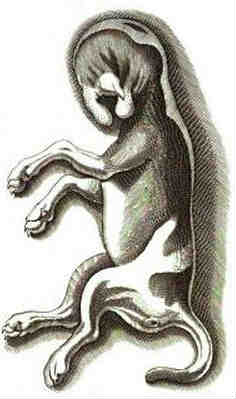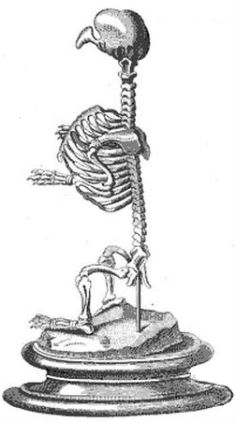Dog × Turkey
Hybrids out of History
Mammalian Hybrids
|
Reserving judgment is a matter of infinite hope.
—F. Scott Fitzgerald
The Great Gatsby |
This highly disparate cross, though reported, requires confirmation from a testable specimen.
The distinguished eighteenth-century German chemist and medical doctor Johann Theodor Eller (1689-1760) served as personal physician to King Wilhelm I and, later, to Wilhelm’s famous son Frederick the Great. As a student, Eller had studied abroad at the best medical schools in Europe. He was the first physician in Germany to variolate patients against smallpox.
While serving as Frederick’s physician, Eller published a paper (Eller 1756) in which he described and pictured an alleged dog-turkey hybrid. It had the body of an ordinary small dog but a turkey-like head (see figures at right). What follows is a translation of the relevant portion of the text (reprinted in Eller 1770, pp. 181-182).
A few months before the paper was written, Eller says, Berlin had witnessed the birth of “a little dog, the head of which resembled that of a turkey [Meleagris gallopavo]. The resident who witnessed the birth of this monstrous little beast gave it to a surgeon of my acquaintance, from whom I obtained it. The owner informed him that
In the past, it was widely believed that the exposure of a mother to a particular animal, especially an exposure that frightened her, could result in a child within the womb taking on the characteristics of that animal. These supposed effects of the mother’s experiences were known as “maternal impressions.” Thus, it was thought that a woman frightened by a dog stood an increased chance of giving birth to a dog-faced baby. This notion was applied also to animals that gave birth to strange offspring with mixed characteristics. But no scientist today would accept a psycho-spiritual explanation of this sort.
So what was this creature? Today, really only two possibilities are worth considering: (1) a strange pup affected by a mutation that coincidentally caused its head to take on various characteristics of a turkey’s (and that was coincidentally birthed by a dog that had been regularly harassed by a turkey); or (2) a dog-turkey hybrid. Of course, it could be that the entire account is a hoax, but this last option seems rather far-fetched given Eller’s lofty reputation.
Imprinting
One relevant fact that can be mentioned in connection with this cross is that dogs have been known to incubate turkey eggs and to care for the resultant hatchlings. Young turkeys subjected to such treatment would be imprinted on dogs when they reached sexual maturity and therefore likely to attempt to mate with dogs. Examples of a dog hatching and caring for turkeys appear in various news stories. For example, the following appeared in the Pascagoula, Mississippi, Democrat-Star (Apr. 20, 1894, p. 1):
Incertae sedis cases
On this website, reports of hybrids that do not exactly fit the criteria for any particular cross, but that seem related to a given cross, are listed as "incertae sedis" at the end of the page for that cross. In Latin, incertae sedis means of "uncertain position."
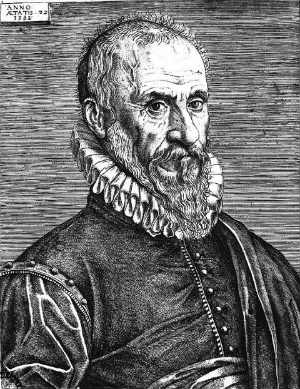 Ambroise Paré
Ambroise Paré(c. 1510 – 1590)
Incertae sedis (1). A very early report (16th century) describes a creature with the body of a dog and the head of a fowl.‡ The crude drawing that accompanied the report is reproduced below. One might suppose that such an animal should be classified under the heading of dog × bird. However, the fact that the report says it was birthed by a woman means that the classification of this report is unclear (thus, incertae sedis). It was first described by Ambroise Paré (c. 1510-1590), personal physician to French kings Henry II, Francis II, Charles IX and Henry III. Paré is remembered as a pioneer of modern surgery, forensic pathology, and battlefield medicine. His brief account (Paré 1641, p. 666) of this specimen reads as follows:
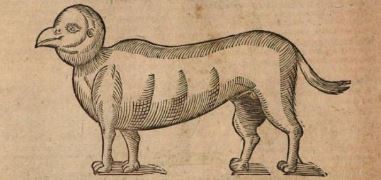 The Antwerp nondescript as pictured in Paré (1641, p. 666).
The Antwerp nondescript as pictured in Paré (1641, p. 666).
Prenzlau. In Prussia, on August 26, 1724, the birth of a stillborn monstrosity of indeterminate sex‡ at Prenzlau was reported. The case is reminiscent of the one just described, in that the creature, birthed by a woman, allegedly combined features of a dog and a turkey (the mouth and nose of a dog, but fleshy growths atop its head like a turkey, as well as nails like those on a turkey’s feet). The notice appeared in the Berlinische privilegirte Zeitung (Sept. 7, 1724, p. 4).
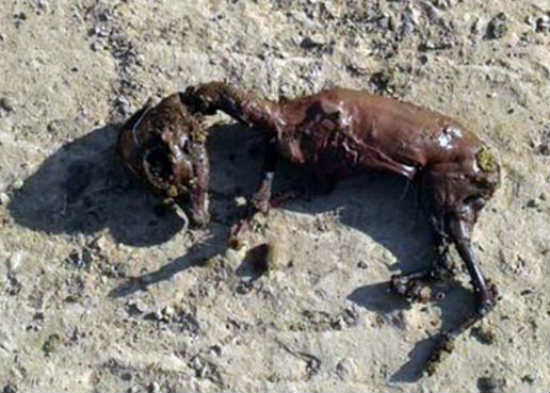 According to news reports, a strange creature allegedly birthed by a goat on May 27, 2015, had the head of a bird. The alleged birth occurred on a farm near the small town of El Cachi in the department of Figueroa, Santiago del Estero, Argentina. News of this event seems not to have made it into English-language reports at the time, but in Spanish it was dubbed the “avecabra” (bird-goat). The picture above was taken by one of the farmer’s neighbors. Reports say it died soon after birth.
According to news reports, a strange creature allegedly birthed by a goat on May 27, 2015, had the head of a bird. The alleged birth occurred on a farm near the small town of El Cachi in the department of Figueroa, Santiago del Estero, Argentina. News of this event seems not to have made it into English-language reports at the time, but in Spanish it was dubbed the “avecabra” (bird-goat). The picture above was taken by one of the farmer’s neighbors. Reports say it died soon after birth.
Incertae sedis (2). A nineteenth century news story reports an animal that might fit under the heading of this cross (dog × turkey). However, from the description given, there is some doubt whether that classification is proper (thus, incertae sedis). At any rate, the story appeared in the Freeland, Pennsylvania, Tribune (Feb. 25, 1897, p. 2, col. 4):
QUEEREST OF BIRDS
It Has the Face of a Cat, Tail of a
Turkey and Feet of a Dog
From all the country miles around people have come to look at the monstrosity, but no one has been able to identify it. Farmer Branthoover was plowing his field when he saw the bird in a tree. He fired at it, and, one of its wings being wounded, it fell to the ground. Then the farmer attempted to pick it up, but a fight which lasted for half an hour ensued, and the sharp beak and talons inflicted wounds the scars of which Branthoover still carries. At last the farmer’s son Ned came to the rescue, and together they succeeded in capturing the queer bird, which has since been confined in the granary.
Many attempts were made to photograph the thing before the effort was successful. The bird would fly into a rage and jump around, as it always does upon the approach of a human being.
The bird measures 18 inches from the top of its head to the tip of its body. The wings are three feet ten inches long and the legs only two inches long. It grunts and barks like a dog.
By the same author: Handbook of Avian Hybrids of the World, Oxford University Press (2006).
